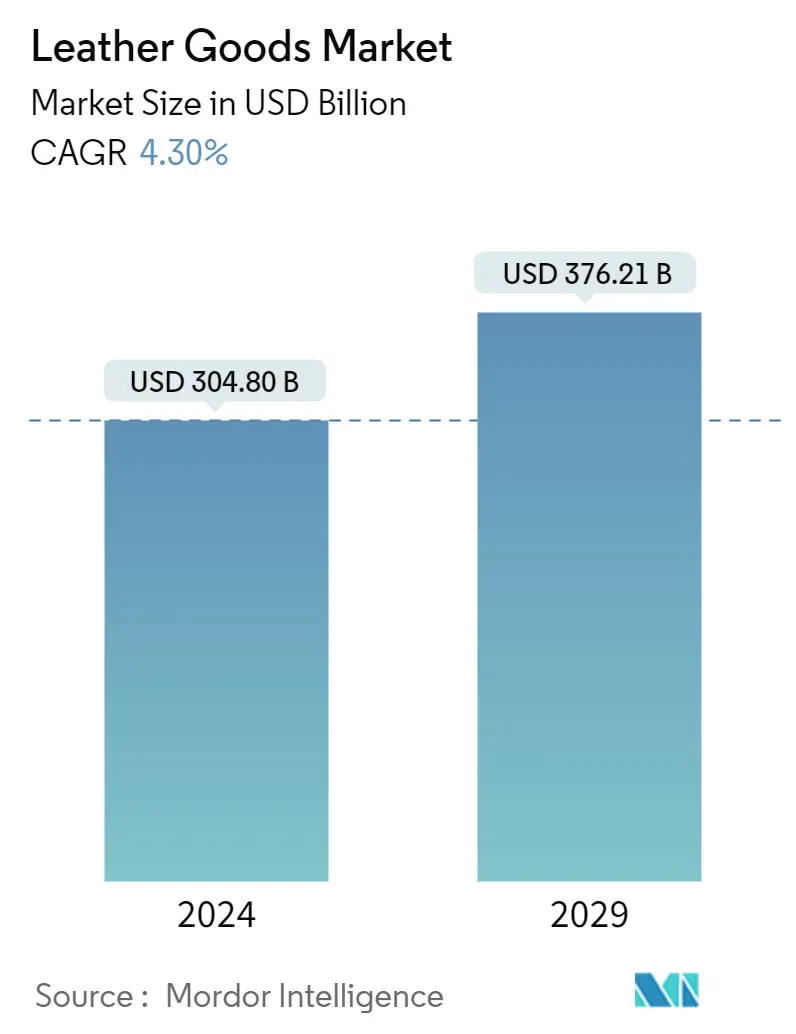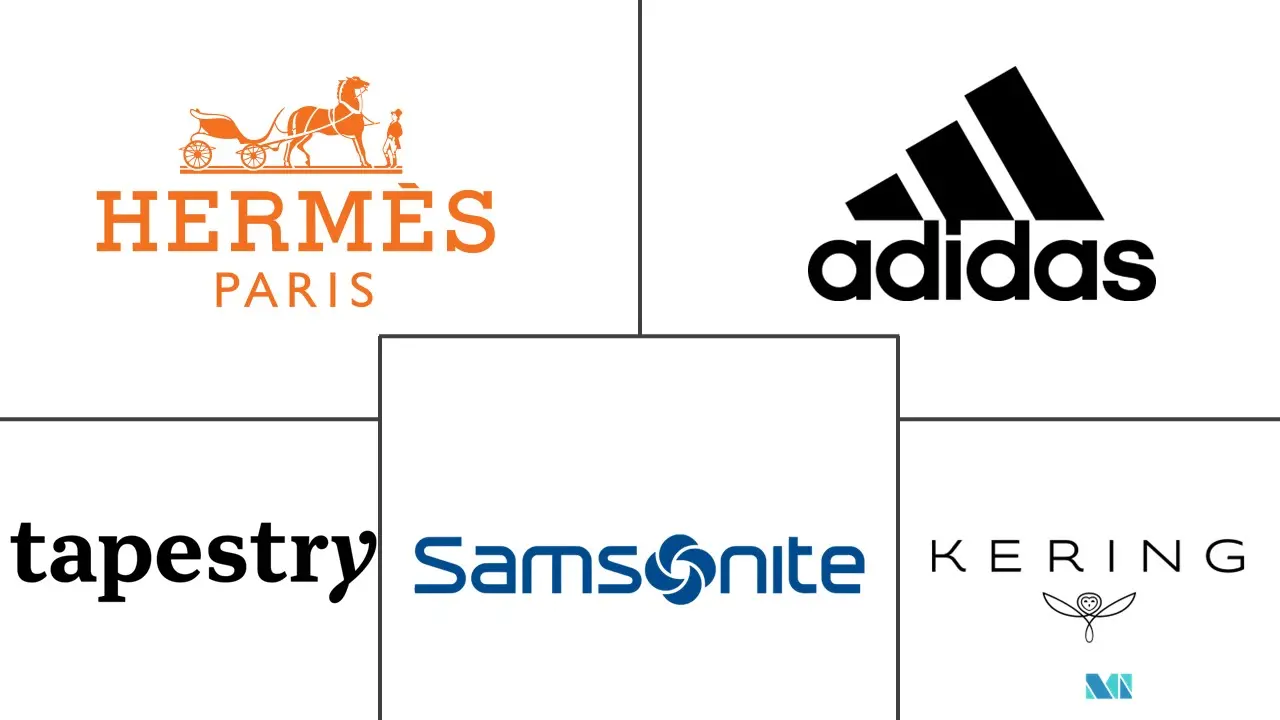Market Size of Leather Goods Industry

| Study Period | 2019 - 2029 |
| Market Size (2024) | USD 304.80 Billion |
| Market Size (2029) | USD 376.21 Billion |
| CAGR (2024 - 2029) | 4.30 % |
| Fastest Growing Market | Asia-Pacific |
| Largest Market | Europe |
| Market Concentration | Low |
Major Players
*Disclaimer: Major Players sorted in no particular order |
Leather Goods Market Analysis
The Leather Goods Market size is estimated at USD 304.80 billion in 2024, and is expected to reach USD 376.21 billion by 2029, growing at a CAGR of 4.30% during the forecast period (2024-2029).
In the clothing industry, there is an increased use of leather due to its durable nature and premium appearance, which make it an excellent choice for clothing production. This is one of the major factors driving the uptake of leather in the market at the moment. Furthermore, leather goods are becoming increasingly popular as a result of fashion shows that showcase leather goods like jackets, shoes, bags, and other accessories that are promoting leather goods in the forecast period. The market players are introducing innovative and trendy products to meet the demands of the consumers and to maintain a loyal customer base, which is contributing to the growth of the market.
Additionally, consumers prefer compact and stylish leather goods and luggage. With changing fashion trends, men's accessories like leather bracelets, necklaces, and gloves are becoming increasingly popular. Thus, in the coming years, fashion trends are likely to change significantly, which will help to grow the industry. Furthermore, the growing government support for the leather industry is further driving market growth. For instance, in India, 100% FDI is allowed for the manufacturing of leather products through an automatic route. Between April 2000 and September 2021, the cumulative foreign direct investment (FDI) inflow in the case of the leather, leather goods, and pickers industries was USD 218.69 million.
Leather Goods Industry Segmentation
Leather goods are products made out of material from tanning hides and the skin of animals, mainly cattle. The process of tanning helps prevent the leather from being damaged while also smoothing its texture. The leather goods market is segmented on the basis of product type, distribution channel, and geography. Based on product type, the market is segmented into footwear, luggage, and accessories. The market is segmented by distribution channel into offline and online retail stores. The research also includes a global level analysis of the major regions, which include North America, Europe, Asia-Pacific, South America, the Middle East, and Africa. The market sizing and forecasts for each segment are based on value (in USD million).
| By Product Type | |
| Footwear | |
| Luggage | |
| Accessories |
| By Distribution Channel | |
| Offline Retail Stores | |
| Online Retail Stores |
| Geography | |||||||||
| |||||||||
| |||||||||
| |||||||||
| |||||||||
|
Leather Goods Market Size Summary
The leather goods market is experiencing a robust expansion, driven by the increasing demand for durable and premium-quality products in the clothing industry. The market is witnessing a surge in the popularity of leather goods, fueled by fashion shows and the introduction of innovative and trendy products by market players. This trend is further supported by the growing consumer preference for compact and stylish leather items, including men's accessories like bracelets and gloves. Government support, such as allowing foreign direct investment in leather manufacturing, is also contributing to market growth. The rise in disposable incomes and the demand for luxury goods, particularly in Europe, North America, and Asia, are propelling the market forward. Luxury leather products, including exclusive handbags and accessories, are particularly appealing to affluent consumers, prompting companies to expand their product portfolios with new launches.
The European market plays a pivotal role in the international leather trade, with a strong presence of local and international players, and a significant contribution to global exports. The region's fashion-driven countries, such as France and Italy, remain key consumers, with increasing fashion consciousness and demand for high-quality leather goods. The market is highly competitive, with major players like Adidas, Samsonite, and Kering focusing on new product offerings and expansion strategies to meet consumer demands. The availability of high-valued raw materials and the presence of family-owned tanners in the European Union further bolster the market. Companies are also investing in sustainable practices, as seen in Tapestry, Inc.'s partnership with the World Wildlife Fund, to enhance traceability in the leather value chain.
Leather Goods Market Size - Table of Contents
-
1. MARKET DYNAMICS
-
1.1 Market Drivers
-
1.2 Market Restraints
-
1.3 Porter's Five Forces Analysis
-
1.3.1 Threat of New Entrants
-
1.3.2 Bargaining Power of Buyers/Consumers
-
1.3.3 Bargaining Power of Suppliers
-
1.3.4 Threat of Substitute Products
-
1.3.5 Intensity of Competitive Rivalry
-
-
-
2. MARKET SEGMENTATION
-
2.1 By Product Type
-
2.1.1 Footwear
-
2.1.2 Luggage
-
2.1.3 Accessories
-
-
2.2 By Distribution Channel
-
2.2.1 Offline Retail Stores
-
2.2.2 Online Retail Stores
-
-
2.3 Geography
-
2.3.1 North America
-
2.3.1.1 United States
-
2.3.1.2 Canada
-
2.3.1.3 Mexico
-
2.3.1.4 Rest of North America
-
-
2.3.2 Europe
-
2.3.2.1 Spain
-
2.3.2.2 United Kingdom
-
2.3.2.3 Germany
-
2.3.2.4 France
-
2.3.2.5 Italy
-
2.3.2.6 Russia
-
2.3.2.7 Rest of Europe
-
-
2.3.3 Asia-Pacific
-
2.3.3.1 China
-
2.3.3.2 Japan
-
2.3.3.3 India
-
2.3.3.4 Australia
-
2.3.3.5 Rest of Asia-Pacific
-
-
2.3.4 South America
-
2.3.4.1 Brazil
-
2.3.4.2 Argentina
-
2.3.4.3 Rest of South America
-
-
2.3.5 Middle-East and Africa
-
2.3.5.1 South Africa
-
2.3.5.2 United Arab Emirates
-
2.3.5.3 Rest of Middle-East and Africa
-
-
-
Leather Goods Market Size FAQs
How big is the Leather Goods Market?
The Leather Goods Market size is expected to reach USD 304.80 billion in 2024 and grow at a CAGR of 4.30% to reach USD 376.21 billion by 2029.
What is the current Leather Goods Market size?
In 2024, the Leather Goods Market size is expected to reach USD 304.80 billion.

